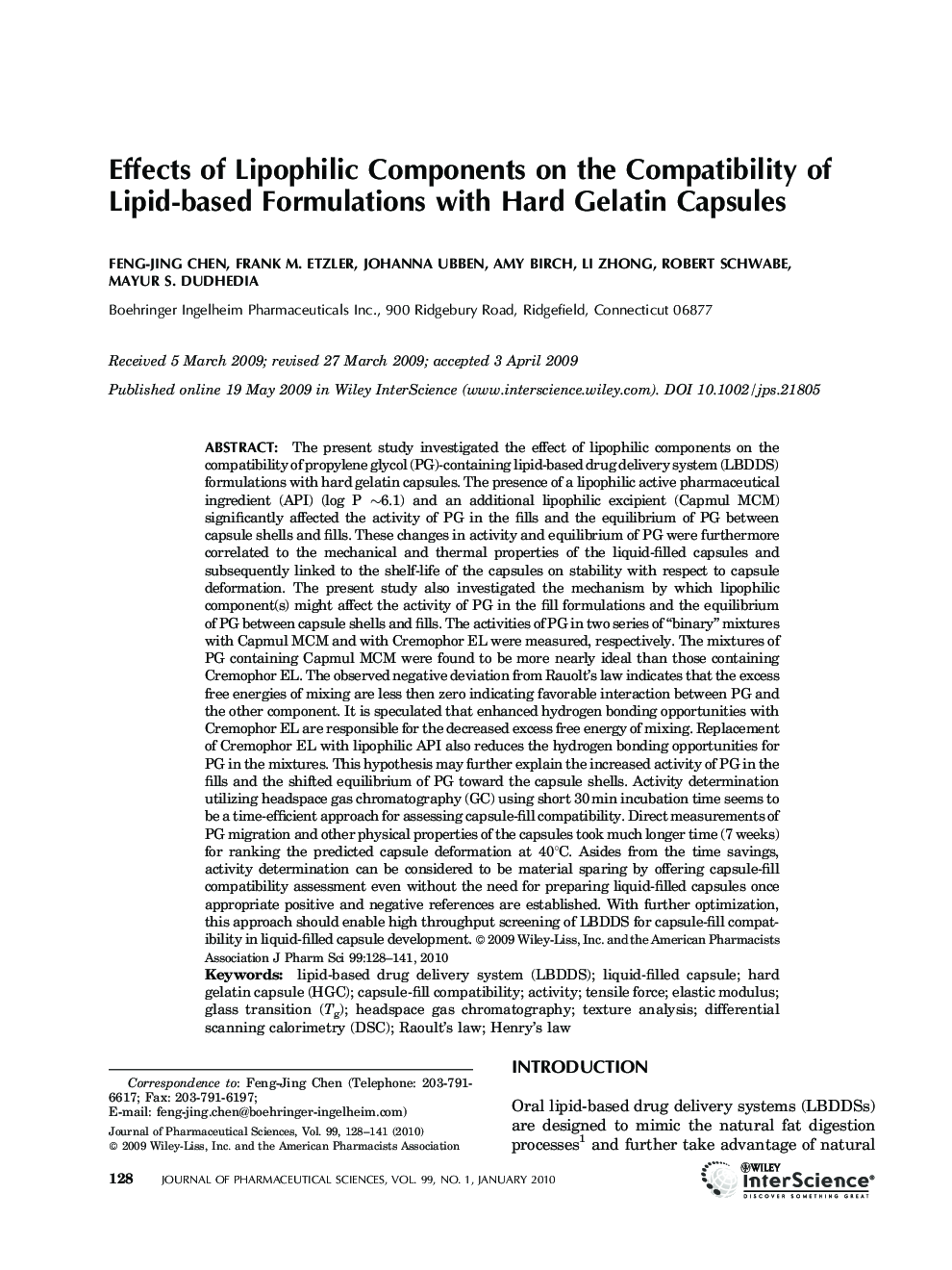| کد مقاله | کد نشریه | سال انتشار | مقاله انگلیسی | نسخه تمام متن |
|---|---|---|---|---|
| 2486217 | 1114378 | 2010 | 14 صفحه PDF | دانلود رایگان |
عنوان انگلیسی مقاله ISI
Effects of lipophilic components on the compatibility of lipid-based formulations with hard gelatin capsules
دانلود مقاله + سفارش ترجمه
دانلود مقاله ISI انگلیسی
رایگان برای ایرانیان
کلمات کلیدی
موضوعات مرتبط
علوم پزشکی و سلامت
داروسازی، سم شناسی و علوم دارویی
اکتشاف دارویی
پیش نمایش صفحه اول مقاله

چکیده انگلیسی
The present study investigated the effect of lipophilic components on the compatibility of propylene glycol (PG)-containing lipid-based drug delivery system (LBDDS) formulations with hard gelatin capsules. The presence of a lipophilic active pharmaceutical ingredient (API) (log P â¼6.1) and an additional lipophilic excipient (Capmul MCM) significantly affected the activity of PG in the fills and the equilibrium of PG between capsule shells and fills. These changes in activity and equilibrium of PG were furthermore correlated to the mechanical and thermal properties of the liquid-filled capsules and subsequently linked to the shelf-life of the capsules on stability with respect to capsule deformation. The present study also investigated the mechanism by which lipophilic component(s) might affect the activity of PG in the fill formulations and the equilibrium of PG between capsule shells and fills. The activities of PG in two series of “binary” mixtures with Capmul MCM and with Cremophor EL were measured, respectively. The mixtures of PG containing Capmul MCM were found to be more nearly ideal than those containing Cremophor EL. The observed negative deviation from Rauolt's law indicates that the excess free energies of mixing are less then zero indicating favorable interaction between PG and the other component. It is speculated that enhanced hydrogen bonding opportunities with Cremophor EL are responsible for the decreased excess free energy of mixing. Replacement of Cremophor EL with lipophilic API also reduces the hydrogen bonding opportunities for PG in the mixtures. This hypothesis may further explain the increased activity of PG in the fills and the shifted equilibrium of PG toward the capsule shells. Activity determination utilizing headspace gas chromatography (GC) using short 30 min incubation time seems to be a time-efficient approach for assessing capsule-fill compatibility. Direct measurements of PG migration and other physical properties of the capsules took much longer time (7 weeks) for ranking the predicted capsule deformation at 40°C. Asides from the time savings, activity determination can be considered to be material sparing by offering capsule-fill compatibility assessment even without the need for preparing liquid-filled capsules once appropriate positive and negative references are established. With further optimization, this approach should enable high throughput screening of LBDDS for capsule-fill compatibility in liquid-filled capsule development. © 2009 Wiley-Liss, Inc. and the American Pharmacists Association J Pharm Sci 99:128-141, 2010
ناشر
Database: Elsevier - ScienceDirect (ساینس دایرکت)
Journal: Journal of Pharmaceutical Sciences - Volume 99, Issue 1, January 2010, Pages 128-141
Journal: Journal of Pharmaceutical Sciences - Volume 99, Issue 1, January 2010, Pages 128-141
نویسندگان
Feng-Jing Chen, Frank M. Etzler, Johanna Ubben, Amy Birch, Li Zhong, Robert Schwabe, Mayur S. Dudhedia,